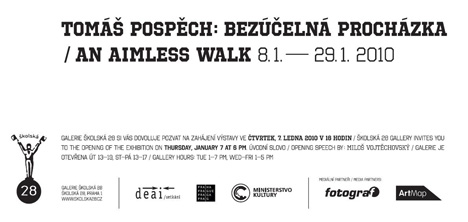18/1/2010
Tomáš Pospěch: BEZÚČELNÁ PROCHÁZKA
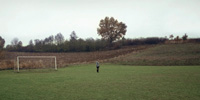 |
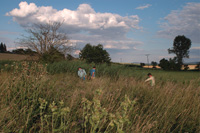 |
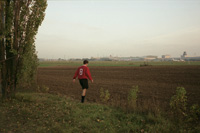 |
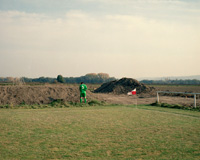 |
Mimo hru
Tématem fotografií Tomáše Pospěcha, které vznikaly poslední čtyři roky především na jaře a na podzim, je venkovský fotbal. Chybí v nich ale vzrušení, svět zaplněných tribun, velkoplošných obrazovek, reklamních mantinelů, fotbalových celebrit. Představují sportovní utkání se svými vrcholovými okamžiky „obrácené naruby“. Zamrzlé, o ničem nerozhodující momentky připomínají „mezipolíčka“ filmu. Vytvářejí jakousi výplň mezi akcelerací zápasu a posunují poselství snímků daleko za hranice sportovní reportážní fotografie, kam se záběry z fotbalu většinou řadí. Autor místo teleobjektivu použil širokoúhlý objektiv, místo pohybu zachytil okamžiky čekání a spoušť stisknul jen v momentu, kdy se ze záběru ztratil míč. Výběru a vyzvětšování se dočkaly ty fotografie, které sportovní fotograf obvykle vyřadí. Téma se v tomto případě vykloubilo ze svého žánru.
Fotbalová hřiště rozkládající se na vesnických periferiích – velmi často v polích, za JZD, u letiště, vedle hřbitova – jsou většinou přirozeně zasazeny do krajinného terénu. Tyto zgeometrizované louky, vymezené z okolní krajiny často jen bílými pásy nakreslenými na posečené trávě, připomínají území potažená velkými sítěmi, které, paradoxně, v branách někdy chybí. Míč tak občas přeletí a proklouzne do krajiny – do jiného prostoru, žánru, do jiné hry, ze které ho hráčům nikdo zpátky nepřihraje. Právě motivem setkání s přírodou v hledání ztraceného míče zakutáleného v houští, plujícího v potoku nebo pohlceného lesem, srůstá na první pohled dokumentární soubor s meditativní a nadčasovou fotografií krajiny.
Nelze si nevšimnout, že autor ani v prostoru „dějové vaty“ nepřikládá větší pozornost vystižení emocí – radosti, úlevy nebo zklamání ve tvářích sportovců. Hráči jsou zobrazeni jako figurky na zelené šachovnici. Čekají na další tah. Děj zápasu ale propadává oky natažené sítě. „Nerozhodující okamžik“ nerozhoduje o výsledku, ale o aktuálních souřadnicích stání v krajině. Stání, které je časově a také prostorově „mimo hru“.
Lucia L. Fišerová
Taken Off
The subject of Tomáš Pospěch’s photographs from the last four years, made mainly in spring and autumn, is football in the countryside. These photos, however, have little or no excitement, no stands full of spectators, no large-screen televisions, no advertising round the perimeter, no celebrities. They show sports matches with the highlights ‘turned inside out’. About nothing decisive, these frozen moments are like the space between film frames. They create some kind of filler between the fast-action moments of the match and they shift the photographic message far beyond the usual bounds of football photography. Instead of using a telephoto lens, Pospěch has used a wide-angle. Instead of capturing motion, he has captured moments of waiting, pressing his shutter release only at the instant the ball is no longer in the shot. He has selected and printed only photos that a sports photographer would usually discard without a second thought. The subject has in this case slipped free of its genre.
The football pitches spreading out on the edges of villages (very often in fields, behind collective farms, at airfields, next to cemeteries) are for the most part naturally set into the landscape. These meadows that have been made geometric, often delimited from the surrounding landscape solely by white stripes painted on to mown grass, bring to mind territories covered with huge nets. Paradoxically, sometimes the goals lack nets, and, consequently, the ball occasionally flies between the goalposts and out into the countryside – into another space, another genre, another game, from which it won’t be passed back to the players. It is this theme of the encounter with Nature, in the search for the lost ball that has rolled off into the bushes, floated downstream, or been swallowed by a wood, that at first makes Pospěch’s documentary set seem to merge with meditative, timeless landscape photography.
It’s impossible not to notice that the photographer, even in the space of the secondary action, has paid little attention to capturing emotion – joy, relief, or disappointment – in the faces of the players. The footballers are depicted as chess players on a green board. They await the next move. The action of the match, however, slips through the cast net. The ‘indecisive moment’ determines the coordinates of the current state of inaction, not the result. In time and space, the current state is ‘taken off’.
Lucia L. Fišerová

